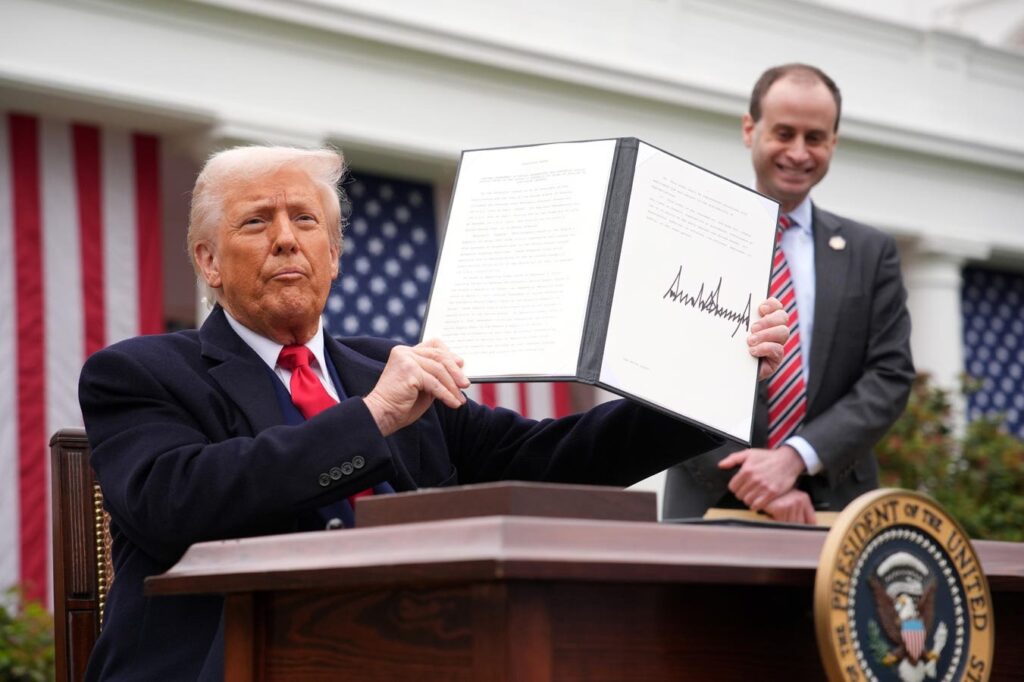“This is Liberation Day. We’ve been waiting for a long time. April 2, 2025, will forever be remembered as the day American industry was reborn,” President Trump boasted at the White House on Wednesday as Trump’s tariffs were unveiled. “In a few moments, I will sign a historic Executive Order instituting reciprocal tariffs on countries throughout the world. Reciprocal – that means (if) they do it to us, we do it to them.”
While the announcement of tariffs on foreign-made products came as no surprise, the amounts of the tariffs and the countries they would be imposed on remained a secret right up until the press conference began. The president has said that these so-called Liberation Day tariffs will “level the playing field for American workers and businesses.”
Trump claims that “for the first time in decades, the United States will see fair trade,” even as political opponents and members of the media have expressed their fears over possibly triggering a global trade war. He cites studies that have repeatedly shown tariffs are an effective tool for achieving economic and strategic objectives. For instance:
- A 2024 study by the Coalition for a Prosperous America said Trump’s tariffs during his first term “strengthened the U.S. economy” and “led to significant reshoring” in industries like manufacturing and steel production.
- A 2023 report by the U.S. International Trade Commission analyzed the effects of tariffs on more than $300 billion of U.S. imports found that the levies reduced the number of imports from China and stimulated more U.S. production of the affected goods with minor effects on prices.
- According to a 2022 report by the Economic Policy Institute, tariffs implemented during Trump’s first term “clearly show[ed] no correlation with inflation” and had only a fleeting effect on overall prices.
“U.S. steel output, employment, capital investment, and financial performance all improved. In particular, U.S. steel producers announced plans to invest more than $15.7 billion in new or upgraded steel facilities, creating at least 3,200 direct new jobs, many of which are now poised to come online.” — Economic Policy Institute
The reasoning behind Trump’s tariffs would create new incentives for U.S. consumers to buy American-made products. The president insists that he is matching the higher levels that our trading partners have charged against U.S. goods for decades.
While Democrats in Congress, economists, and academics are warning that the tariffs would be detrimental to the overall U.S. economy, last year, former Treasury Secretary Janet Yellen said last year that she did not believe that American consumers will see any meaningful increase in the prices because of them.
The tariffs set to go into effect on Thursday, April 3, 2025, will alter trade arrangements that were established shortly after the end of WWII in 1947. Trump also announced an additional 25% global tariff on auto imports that will take effect immediately.
In response, Canada, China, and Mexico have already announced retaliatory tariffs. Other companies are likely to follow. This week, economists at Yale University announced that a 20% tariff on top of those already imposed would cost $3,400-4,200 per household on average.
Related: Here’s The Full List Of Trump’s Reciprocal Tariffs Announced Wednesday
Trump maintains that American workers and manufacturers have been hurt for decades by trade deals that led to a global trade deficit that exceeds $1.2 trillion.
The Impact of Trump’s Tariffs on Small Businesses
1. Small businesses that import and distribute foreign-made goods will feel the impact of higher tariffs immediately. They will be paying more for high end products such as French wine, cheese, perfumes, fashion and accessories, as well as cars from Germany and Japan, oil from Canada and the Middle East, steel and consumer goods from China, pharmaceuticals made in Ireland, and produce from Mexico.
2. Companies not directly involved in the import-export business will be impacted. For instance, automobile owners can expect increases in the cost of repairs as foreign-made parts will be taxed.
3. Small businesses need to brace for changes in cash flow. The tariffs will increase the cost of the foreign-made goods and materials. This new reality will hurt earnings unless small business owners are able to pass along the price increases to consumers without losing sales.
4. Supply chains could be disrupted. Tariffs can disrupt the global supply chain, which means that small businesses may encounter difficulty in getting the goods they need. This can result in unhappy customers for small businesses.
5. Anti-American sentiment may hurt exporters. Small businesses that sell American-made items overseas will be subject to retaliatory tariffs imposed by U.S. trading partners. One cannot ignore rising anti-American sentiment and potential boycotts of U.S. products due to anger over trade wars. Many exporters could see their margins shrink.
Related: Nine Ways To Boost Small Business Earnings
How Small Businesses Can Respond to Trump’s Tariffs
1. Communicate. If you plan to respond to higher costs of imported goods and materials by raising prices, let your customers know that price increases are coming and explain the reason why. For instance, high quality restaurants should emphasize that they are unwilling to compromise on the quality of their ingredients. Likewise, if you opt to begin using domestically made products, communicate that as well. You may gain customers who are happy to learn you’ve made a decision to “buy American.”
2. Negotiate. If you are a big customer of a supplier who provides foreign goods, use your volume as pricing power. Set a limit on how much, if any, of the increase related to higher tariffs that you are willing to absorb. Perhaps you can strike a deal to split the difference.
3. Research. Now is a good time to reevaluate your supply chain. Determine whether you can find lower prices from new suppliers or if you can substitute lower-priced imported products and materials without hurting quality.
4. Reduce. Perhaps your small business will be better able to absorb the higher cost of imported goods by evaluating and streamlining your current operations. Consider eliminating low-margin items that may not be selling well. If commercial rents are declining, see if you can renegotiate your lease. Examine areas of potential labor cost savings, such as automating repetitive processes. Consider hiring interim or fractional (part-time) senior executives instead of hiring full-time employees. “You can access top-tier talent and strategic insights without the commitment of a full-time hire,” says Mark Viner, president of ZRG Interim Solutions.
5. Capitalize. If you are not in a financial position to absorb higher prices that are likely to immediately go into effect, you may want to secure capital to prepare for a new, higher cost structure. Consider applying for a working capital loan or applying for a business line of credit, which acts a reserve fund from which you can withdraw money as you need it and pay back only the amount of money that you borrow. With potential interest rate cuts by the Federal Reserve later this year, you may be able to secure financing at a lower cost of capital.
With the Trump back in the White House, unpredictability is the norm. Small business owners should prepare for Trump’s tariffs and the administration’s next moves – whatever those might be – by being ready financially for potential rising costs and formulating a response.
Read the full article here











